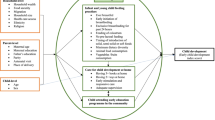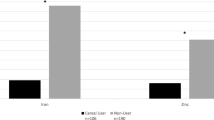Abstract
The objective of this study was to assess the impact of caregiving arrangement on the iron and folate status of infants and toddlers reared at home or enrolled in centre-based, independent home, or licensed home care. One hundred and eighty-nine children aged 2 to 29 months were assessed 1 month prior to child care entry and at 6 months after entry into child care. Dietary (24-hour records), anthropometric (height, weight, head circumference) and biochemical (red blood cell folate, hematocrit, transferrin, and serum ferritin concentrations) methods were used to assess nutritional status. Frequency of illness was determined by a series of telephone interviews. Median intake of nutrients exceeded Canadian recommendations, regardless of care arrangement. Fifteen of 65 children had hematocrit values below age-specific cutoffs at the 6-month post-entry to child care visit. Children were frequently taken to obtain medical advice (average of 4 to 6 times during the study period) and 75% of subjects were prescribed at least one course of antibiotics. In conclusion, infants and toddlers in this study were generally well nourished, regardless of child care arrangement; however, iron status may remain an issue in this sample of infants and toddlers.
Résumé
Cette étude avait pour objectif d’évaluer l’impact du type de garderie choisi pour des nourrissons et des tout-petits, élevés à la maison ou inscrits dans des centres ou des services de garderie à domicile agréés, sur leur bilan en fer et en acide folique. Cent quatre vingt neuf (189) enfants âgés de 2 à 29 mois ont fait l’objet d’un examen un mois avant leur entrée dans un service de garderie et six mois plus tard. Pour évaluer leur état nutritionnel, on s’est servi des mesures anthropométriques (taille, poids, périmètre crânien) et biochimiques (acide folique dans les globules rouges, hématocrite, transferrine et concentrations de ferritine sérique) ainsi que des données diététiques (registres tenus 24 h sur 24 h). La fréquence des maladies a été déterminée à l’aide d’une série d’entretiens téléphoniques. l’apport moyen en nutriments dépassait les recommandations canadiennes, quel que soit le type de garderie choisi. Lors de l’examen fait six mois après leur entrée dans un service de garderie, l’hématocrite était inférieure aux seuils de rétention selon l’âge chez 15 enfants sur 65. Les consultations médicales pour les enfants avaient été fréquentes (de 4 à 6 en moyenne pendant la période à l’étude) et des antibiotiques avaient été prescrits au moins une fois à 75% des sujets. En conclusion, on peut dire que les nourrissons et les tout-petits étaient en général bien nourris quel que soit le type de garderie choisi; toutefois, pour cet échantillon, le bilan en fer pouvait apparaître problématique.
Similar content being viewed by others
References
Lehmann F, Gray-Donald K, Mongeon M, Di Tommaso S. Iron deficiency anemia in 1-year-old children of disadvantaged families in Montreal. Can Med Assoc J 1992;146:1571–77.
Chan-Yip A, Gray-Donald K. Prevalence of iron deficiency among Chinese children aged 6 to 36 months in Montreal. Can Med Assoc J 1987;136:373–78.
Evers S, Rand C. Morbidity in Canadian Indian and non-Indian children in the second year. Can J Public Health 1983;74:191–94.
Nutrition Committee, Canadian Paediatric Society. Meeting the iron needs of infants and young children: An update. Can Med Assoc J 1991;144:1451–54.
Innis SM, Nelson CM, Wadsworth LD, et al. Incidence of iron-deficiency anemia and depleted iron stores among nine-month-old infants in Vancouver, Canada. Can J Public Health 1997;88:80–84.
Health and Welfare Canada. Nutrition Canada: Food Consumption Patterns Report. Ottawa, Ontario: Canadian Government Publishing Centre, 1977.
Nova Scotia Heart Health Department Program, Nova Scotia Department of Health, Health and Welfare Canada. Report of the Nova Scotia Nutrition Survey. Nova Scotia, 1993.
Drake MA. Anthropometry, biochemical, iron indexes, and energy and nutrient intake of preschool children: Comparison of intake at day care center and at home. J Am Diet Assoc 1991;91:1587–88.
Johnson RK, Smiciklas-Wright H, Crouter AC, Willits FK. Maternal employment and the quality of young children’s diets: Empirical evidence based on the 1987–1988 Nationwide Food Consumption Survey. Pediatr 1992;90:245–49.
Campbell ML. The nutrient intake, growth, and eating pattern of preschool children with single, employed mothers. J Can Diet Assoc 1993;54:151–56.
Stinnett JD. Nutrition and the Immune Response. Florida: CRC Press Inc., 1983.
Doyle AB. Incidence of illness in early group and family day-care. Pediatr 1976;58:607–13.
Wald ER, Dashefsky B, Byers C, et al. Frequency and severity of infections in day care. J Pediatr 1988;112:540–46.
Ponka A, Nurmi T, Salminen E, Nykyri E. Infections and other illnesses of children in day-care centres in Helsinki I: Incidences and effects of home and day-care center variables. Infection 1991;19:230–36.
Woolridge MW, Butte N, Dewey KG, et al. Methods for the measurement of milk volume intake of the breast-fed infant. In: Jensen RG, Neville MC (Eds.), Human Lactation: Milk Components and Methodologies. New York, NY: Plenum Publishing Corporation, 1985;5–21.
Klesges RC, Klesges LM, Brown G, Frank GC. Validations of the 24-hour dietary recall in preschool children. J Am Diet Assoc 1987;87:1383–85.
Eck LH, Klesges RC, Hanson CL. Recall of a child’s intake from one meal: Are parents accurate? J Am Diet Assoc 1989;89:784–89.
Consumer and Food Economic Institute. Composition of Foods: Raw, Processed and Prepared. Agriculture Handbook no. 8 series. Washington, DC: US Government Printing Office, 1976–1991.
Health and Welfare Canada. Nutrient Value of Some Common Foods. Ottawa, Canada: Ministry of Supply and Services, 1988.
Wilson SD, Horne DW. High performance liquid chromatographic determination and distribution of naturally occurring folic acid derivatives in rats. Anal Biochem 1984;142:529–53.
Engelhardt R, Gregory III JF. Adequacy of enzymatic deconjugation in quantification of folate in foods. J Agric Food Chem 1990;38:154–58.
Tamura T. Microbiological assay of folates. In: Picciano MF, Stokstad ELR, Gregory JF III, (Eds.), Folic Acid Metabolism in Health and Disease. New York, NY: Wiley-Liss Inc, 1990;121–37.
Steel RGD, Torrie JH. Principles and Procedures of Statistics: A Biometrical Approach 2nd ed. New York: McGraw-Hill, 1980.
Farkas L. Anthropometry of the Head and Face 2nd ed. New York: Raven Press, 1994.
Frisancho AR. Anthropometric Standards for the Assessment of Growth and Nutritional Status. Ann Arbor, Michigan: The University of Michigan Press, 1990.
Dibley MJ, Goldsby JB, Staehling NW, Trowbridge FL. Development of normalized curves for the international growth reference: Historical and technical considerations. Am J Clin Nutr 1987;46:736–48.
Health and Welfare Canada. Nutrition Recommendations: The Report of the Scientific Review Committee. Ottawa, Canada: Ministry of Supply and Services, 1990.
Food and Nutrition Board. Recommended Dietary Allowances 10th ed. Washington, DC: National Academy Press, 1989.
Saarinen UM, Siimes MA. Iron absorption from breast milk, cows’ milk, and iron supplemented formula: An opportunistic use of changes in total body iron determined by haemoglobin, ferritin, and body weight in 132 infants. Pediatr Res 1979;113:143–47.
Garry PJ, Owen GM, Hooper EM, Gilbert BA. Iron absorption from human milk and formula with and without iron supplementation. Pediatr Res 1981;15:822–28.
Evers S, Hooper M. Dietary intake and anthro-pometric status of 7 to 9 year old children in economically disadvantaged communities in Ontario. J Amer Coll Nutr 1995;14:595–603.
Gibson RS. Principles of Nutritional Assessment. New York: Oxford University Press, 1990.
Fomon SJ. Nutrition of Normal Infants. St. Louis: Mosby-Year Book, Inc., 1993;239–60.
Greene-Finestone L, Feldman W, Luke B. Prevalence and risk factors of iron depletion and iron deficiency anemia among infants in Ottawa-Carleton. J Can Diet Assoc 1991;52:20–23.
Zlotkin SH, Ste-Marie M, Kopelman H, et al. The prevalence of iron depletion and iron-deficiency anaemia in a randomly selected group of infants from four Canadian cities. Nutr Res 1996;16:729–33.
Looker AC, Dallman PR, Carroll MD, et al. Prevalence of iron deficiency in the United States. JAMA 1997;277:973–76.
Alaimo K, McDowell MA, Briefel RR, et al. Dietary intake of vitamins, minerals, and fiber of persons ages 2 months and over in the United States: Third National Health and Nutrition Examinination Survey Phase I, 1988–91. Advance data from vital and health statistics. Hyattsville, MD: National Center for Health Statistics, 1995;255.
Konijn AM, Hershko C. Ferritin synthesis in inflammation: Pathogenesis of impaired iron release. Br J Haematol 1977;37:7–16.
Hercberg S, Galán P, Chauliac M, et al. Nutritional anaemia in pregnant Beninese women: Consequences on the haematological profile of the newborn. Br J Nutr 1987;57:185–93.
Borch-Iohnsen B, Meltzer HM, Stenberg V, et al. Bioavailability of daily low dose iron supplements in menstruating women with low iron stores. Eur J Clin Nutr 1989;44:29–34.
Author information
Authors and Affiliations
Corresponding author
Additional information
This work was supported, in part, by the Child Care Initiatives Fund of Health Canada.
Rights and permissions
About this article
Cite this article
Goodwin, R.A., Buchholz, A.C., McKim, M.K. et al. Caregiving Arrangement and Nutrition: Good News with Some Reservations. Can J Public Health 90, 45–51 (1999). https://doi.org/10.1007/BF03404099
Received:
Accepted:
Published:
Issue Date:
DOI: https://doi.org/10.1007/BF03404099




